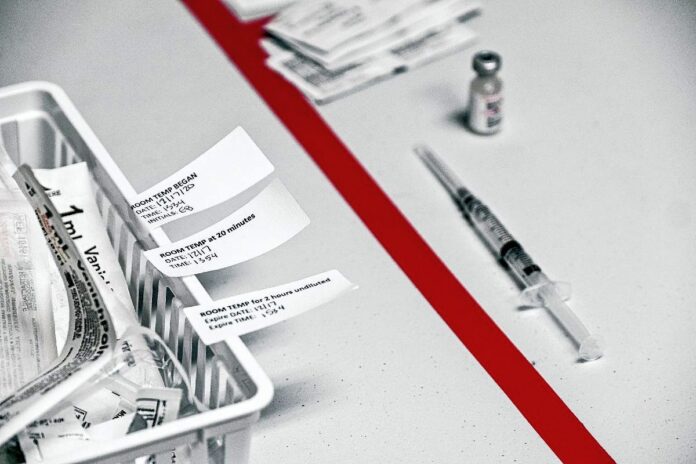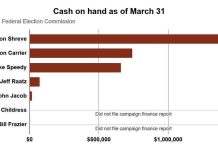
COLUMBUS, Ind. — Local health officials are concerned about pandemic fatigue and a “false sense of security” among residents as hospitalizations and infection rates start to fall from the sky-high levels seen during the winter surge because more cases of the U.K. variant of the virus are being detected in Indiana.
A total of 163 Bartholomew County residents tested positive for COVID-19 from Feb. 12 to 18, down from 178 the week prior, according to the Indiana State Department of Health.
By comparison, 587 Bartholomew County residents tested positive for COVID-19 the week ending Nov. 22 and 390 the week ending Jan. 10.
Metrics from the COVID-19 Community Task Force also show a declining weekly per-capita positivity rate in the county falling to 25.4 per 100,000 residents on Wednesday, down from 106.4 per 100,000 on Nov. 20 and 60.7 on Jan. 13.
Additionally, there were 11 patients hospitalized with COVID-19 at Columbus Regional Health this past Wednesday, down from 59 in early December, the hospital said.
While many metrics are trending down in Bartholomew County, hospitalizations and positivity rates are still higher than in the early fall, including Wednesday’s weekly per-capita positivity, which was still more than triple the rate of 6.8 per 100,000 residents on Sept. 2.
The hospital went 45 consecutive days with fewer than 10 hospitalizations from Aug. 27 to Oct. 10.
Dr. Slade Crowder, CRH vice president of physician enterprise operations, said he is concerned about “COVID fatigue” and the “logical but incorrect assumption that we’re out of the woods.”
“While the trends are coming down, we’re coming down from very high peaks,” Crowder said. “…We still have high community spread in Bartholomew County, and it’s easy to kind of lose sight when we had such a high peak. It’s easy to get a false sense of security that things are getting back to normal.”
The trends in Bartholomew County mirror similar patterns seen in much of the U.S. as the country starts to come out of a surge that sickened at least 14.7 million people in the U.S. and killed 228,042 since Thanksgiving, including 71 in Bartholomew County.
As of Thursday, there were 62,300 people hospitalized with COVID-19 in the U.S., down from 131,326 on Jan. 12, according to the COVID-19 Tracking Project. A total of 850,740 people in the U.S. have been hospitalized since the pandemic started.
In Indiana, there were 948 people hospitalized with confirmed or suspected COVID-19 infections on Wednesday, down from 3,460 on Nov. 30 and 2,836 on Jan. 3, according to the Indiana State Department of Health.
On Wednesday, state officials said the positivity rate in Indiana had fallen to 4.7% this week, compared to 6.2% last week.
On Jan. 12, the positive rate in Indiana was 11.9%.
Bartholomew County Health Officer Dr. Brian Niedbalski said that he suspects that the large number of local residents who have had COVID-19 in recent weeks and may have some degree of immunity and the vaccination efforts are likely contributing to the downward trends to some extent.
About 6.7% of the county’s population has tested positive for COVID-19 since Nov. 1, according to state records.
About 13.2% of the county’s population has received one dose of a COVID-19 vaccine and 5.3% have received their second dose and are considered fully vaccinated.
Health experts still do not know how long a person may be immune to COVID-19 after being infected, if at all, or what level of protection they may have against the virus.
“I believe that there are a significant number of people out there who had COVID, whether symptomatic or not, who still have antibodies making them immune,” Niedbalski said. “This is by no means herd immunity, but might be cutting down on transmission of the virus. More and more individuals getting vaccinated in our county has to also help to some degree.”
Crowder said the decrease in hospitalizations does not necessarily indicate a decrease in community spread, adding that many of the most high risk populations have been vaccinated or are in the process of getting shots.
Bartholomew County residents age 60 and up make up 22.8% of confirmed of all confirmed COVID-19 cases but nearly 90% of all deaths, according to state figures.
Currently, Hoosiers age 65 and up, as well as healthcare workers and first responders, are eligible to get vaccinated.
However, two local residents in their 30s have died from COVID-19, as well as three people in their 40s.
“We’ve immunized the highest-risk people, the nursing home patients,” Crowder said. “Those 65 and older are starting to get immunized, and so those were the people who ended up in the hospital. So you still got to look at the community spread and realize there’s still 30, 40, 50-year-olds who aren’t immunized who can still get sick. Maybe they don’t end up in the hospital, but they still could miss a week or two of work.”
“Even if hospitalizations go down, it doesn’t necessarily mean the community spreads getting that much better,” Crowder added.
U.K. variant
The local downward trend in confirmed cases and hospitalization comes as the U.S. is scrambling to expand DNA mapping to identify more contagious and potentially more deadly mututations that are starting to spread around the country, The Associated Press reported.
As of Thursday, 1,523 cases of a highly contagious U.K. variant of the virus, known as B.1.1.7, had been in the 42 states, including 14 cases in Indiana, according to the Centers for Disease Control and Prevention.
On Wednesday, the White House announced a scaled up push by the Centers for Disease Control and Prevention, and by a U.S. Army biodefense institute, according to wire reports. But the more significant action is on Capitol Hill, where a House bill headed for floor debate would provide $1.75 billion for genomic sequencing.
The U.S. now maps only the genetic makeup of a minuscule fraction of positive virus samples, a situation some experts liken to flying blind, according to wire reports. It means the true domestic spread of problematic mutation first identified in the United Kingdom remains a matter of guesswork.
Such ignorance could prove costly. One worry is that more transmissible forms such as the UK variant could move faster than the nation’s ability to get the vaccine into people’s arms, according to wire reports.
The CDC says the variant spreads more easily and quickly than other variants and “experts in the UK reported that this variant may be associated with an increased risk of death,” though more studies are needed to confirm the finding.
Crowder said CRH is unaware of any patients testing positive for the U.K. variant here.
Crowder and Niedbalksi are urging people “remain vigilant” and to continue wearing masks, avoid crowds and maintain at least 6 feet of physical distance from people they don’t live.
“The newer strains are definitely a concern, as there remains great uncertainty about how this virus will react and spread in the coming months,” Niedbalski said. “As more and more people continue to get vaccinated, I am hopeful that we will avoid another large surge in our region.”




